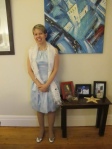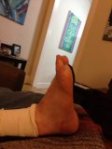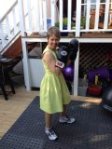(Beginning of narrative starts at bottom with Finding my Feet)
It has been a bit of a ride these past four months with both highs and lows. But the highs outnumber the lows, so I will start with those.
- Standing. Now that I have become use to standing with my whole foot, including the balls of my feet, I am starting to forget how challenging this simple act once was. There was a time, only four months ago, when I was constantly aware of the risk of going over on my ankles, such was the degree to which my feet supinated (balancing my weight on the outsides of my feet). Whilst I still need to bring conscious attention to keep my weight more forward than I have been accustomed to, it is an amazing thing to stand upright and straight with normal effort.
- Normal looking feet. No small thing, my feet now fit into a greater range of shoes than they once did. Apparently I have a year to go before I can sport small heels, but I’m more than happy with cute flats. Where once my high arches meant I would ‘pop out’ of flats, now they sit comfortably. Where once my ankles looked crooked, my feet are now properly aligned. And now that my feet are straight, they don’t twist the shape of my shoes over time.

In cute flats – going to the Christmas party (3 months post surgery. There was even a bit of dancing. Amazing!
- Physical feats. As we set up our new home gym – to support my re-building and re-strengthening – I learned I was now much improved at certain specifics things, including: lunges, squats and boxing! Before when I did lunges, especially on my left side, my highly arched foot would twist and then so too would my knee. Where it had been impossible for me to do a ‘normal’ lunge, I can now lower my knee down straight supported by my foot! ‘Squats’ had also been challenging as I was constantly fighting my arches as I tried to lean back. Boxing was always an effort – not the punching – but rather the planted stance required to balance and throw a punch with the whole body.
And the harder parts of my journey, both physically and psychologically:
Walking. My walking is very slow. And awkward. And difficult. My surgeon, Dr Warren, and my physio at rehab had told me I had to learn to forget about walking. But I’m finding that nearly impossible. I am highly conscious of my slow and plodding gait, especially when going uphill and downhill. Whilst I don’t use my crutch very often (mostly to stand straight when I fatigue), I carry it with me whenever I walk outside. I still use it as a ‘crutch’ for my sense of security; it also helps to signal to others that this is why I’m slow.
It’s also challenging to have full range of motion in stiffer dress shoes for work, versus my runners or Birkenstocks. It’s bloody hard and bloody discouraging at times. Who the hell spoke about dancing when walking is so challenging?
Progress. I had disappointing news from my current physiotherapist, Dan, a couple of days ago. Apparently my progress is not where it should be at this point (whereas the feedback in my earlier appointments had been positive and encouraging). I’m not following through on my step; that is, I’m not pushing through from the ball of my foot at the end of the step motion. The problem is in part my very weak calves. They are weak from being in casts for so long, from not really being fully utilised in my former life, and because of the CMT. And it’s discouraging that they are currently capable of so little at the moment. In order to push up onto my toes I have to lean on a table for support. The other, not insignificant part of the issue, is my old fears of falling over or tripping. This will be just as challenging to overcome.
So I have a new batch of exercises to add to my list, including practising that isolated part of lift off – almost tricking my brain. I also need to stretch my foot downwards to increase the range of motion. I should be walking up and down hills on a daily basis. And I should be swimming 5 times a week to increase strength in my feet and calves. 5 times! I told my local GP that I should dedicate my full schedule to my rehabilitation. He told me that that’s what athletes do when they’re injured. But given I have a demanding full time job, that’s just not possible. Even if I now make time for a dedicated swimming routine, that includes practising standing on tiptoe and use of swim flippers, I can expect very slow and incremental progress. That’s a tough message when I have been diligent with my daily set of exercises for over two months now. It’s frustrating and all encompassing.
My surgeon, Dr Ellis, did tell me it would take a full year. I now have a visceral understanding of what that means. Actually, I will be happy if it ONLY takes a full year. At this point, I worry that I won’t be where I want to be by September 2013. But I’m now off to go swimming and re-dedicate myself to this process. Wish me luck!


